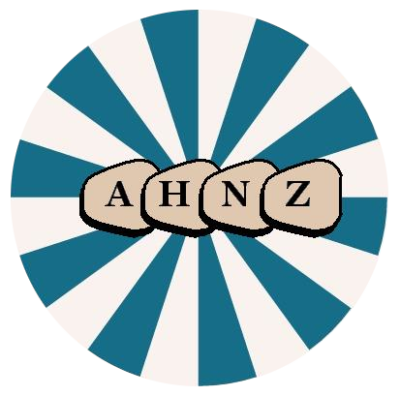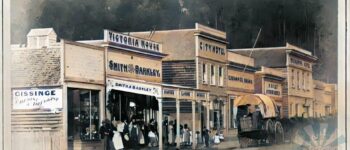1888: Reefton’s Electric Christmas
December 31, 2024
By AHNZ
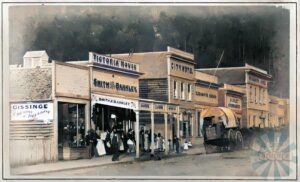
The year 1870 marked a new phase in New Zealand gold mining with the discovery of deposits in the Inangahua Valley; Reefton. If not for the new stimulus of Reefton quartz and Kumara alluvial the West Coast’s Golden days would have been done. Many who had come to the Coast for gold had already moved on before the revival kicked in.
Richard Shield discovered the gold in June 1870 and Inangahua County was founded in 1872 with a courthouse that still stands today (image below.) The nature of the gold and the nature of the founders of Reefton created a unique set of circumstances and the unprecedented Electric Christmas of 1888.
The Utmost Difficulties
Human groups have a very long history, and prehistory, of cooperating to process large prey animals. Finding, tracking, killing, and extracting value from big animals like the wooly mammoth or buffalo are early examples. By forming up into a suitable economic organisation a community could encounter and overcome, then process into wealth, a large animal into food and fibre. And, do so before it spoiled. (I speculate elsewhere that the ingrained echo of this culture is still so strong that it has been sublimated into the game of….cricket. Ref. Cricket Theory, AHNZ)
Humans fell on the untapped wealth of Reefton like primitive man falling on a wooly mammoth or perhaps a beached whale. There a body of some 40 miles of gold-bearing quartz to be served into a feast. However, these men and women were not members of one particular race or tribal group. They were people who shared Ancestors of the Mind, a cultural continuity. A capitalist colony formed with the special organising skills required to extract minerals out of hard rock and turn it into wealth. These sorts of truly diverse communities were bound together by complementary abilities in a free market not common language, race, nation, or even sex. This sort of industrial organisation, although powered by steam, horses, and labour power, resembles primitive people ‘swarming’ a fallen prey animal 100,000 years before. Nor is it unusual for humans to seek minerals rather than food. Maoris had been doing it in the area for hundreds of years, their economy organised around greenstone.
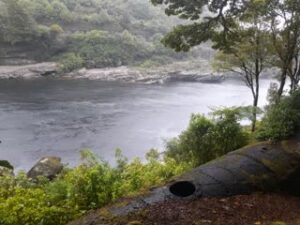 However Reefton’s economy belonged to a different age of mankind. It had to by necessity because only a free market economy could develop and sustain such a difficult undertaking in the remote wilds of the West Coast. The logistics are staggering. The nearest waterway was at Inangahua Landing 25km away with another 50km of river to travel to Westport. The rest had to come via mud tracks using horses though a rainforest subject to the most appalling weather. The people, supplies, equipment, food, etc. all depended on such supply lines. The great quartz-crushing batteries required very heavy machinery and a class of genius people not only to use it but to figure out how to get it to site. In most cases that machinery is still there for you to find among the bush; Ruins of a bygone age. There were also genius people who knew how to find gold reefs. To wrangle people. To establish camps. To clear land. To bring water. To feed everyone. To set the machinery and make it work and work efficiently. To pour the beer that lubricated these various brains so they could pull off the many miracles. The list goes on!
However Reefton’s economy belonged to a different age of mankind. It had to by necessity because only a free market economy could develop and sustain such a difficult undertaking in the remote wilds of the West Coast. The logistics are staggering. The nearest waterway was at Inangahua Landing 25km away with another 50km of river to travel to Westport. The rest had to come via mud tracks using horses though a rainforest subject to the most appalling weather. The people, supplies, equipment, food, etc. all depended on such supply lines. The great quartz-crushing batteries required very heavy machinery and a class of genius people not only to use it but to figure out how to get it to site. In most cases that machinery is still there for you to find among the bush; Ruins of a bygone age. There were also genius people who knew how to find gold reefs. To wrangle people. To establish camps. To clear land. To bring water. To feed everyone. To set the machinery and make it work and work efficiently. To pour the beer that lubricated these various brains so they could pull off the many miracles. The list goes on!
Then, when Reefton’s people produced gold in commercial form they still needed to get it to market. They needed financial institutions. Banks, a stock exchange. And they had it! They had bankers, investors, speculators. Reefton had an entire class of such people to assess and weigh the risks of the proposals and suggestions offered by prospectors and miners for development. Without such investors, men who had to know their business well, Reefton would not have been possible. Nor would such men have been able to do their best or even function without the support industries that Reefton also attracted. Not just trade stores like blacksmiths and timber yards, or consumer suppliers like butchers and bakers. There also had to be suppliers of hats, stationary, dresses, wallpaper, carpet, fine foods, medicine, grooming, suits. Of such things a habitat is furnished where top-tier capitalists can make the big risk decisions and practice their art of the deal.
“…diggers departed in 1868 for Thames and Queensland…At its nadir in 1874 the Coast’s population was only 6,000 below the 1867 peakand it recovered thereafter with the stimulus of Reefton quartz, Kumara alluvial and Grey and Buller coal.” – p884, NZH (1971)
“The year 1870 marked a new phase in gold mining. This was brought about by the discovery of auriferous quartz reefs in the Inangahua district…The utmost difficulties had to be overcome in the opening up of the earliest mines, and in getting crushing machinery on to several of the claims.” p248, Lord (ee1976)
No government project. Free people, overcoming the utmost difficulties, created spontaneous order out of mutual self-interest. Glorious Colonial Anarchy. Our Provincial High (First Turning) time period.
The Reeftonites of Quartzopolis
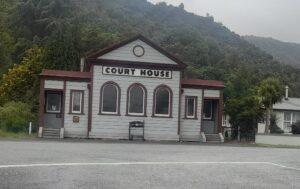 The Christchurch Press sent its roving reporter, The Warrigal (Frederick Rollitt¹) to report on Reefton in 1887, its 15th year. By now the courthouse (left) was well up and running and Reefton, aka Quartzopolis, was in the process of developing its electric power grid. Ref. 1886: Reefton Electric, AHNZ
The Christchurch Press sent its roving reporter, The Warrigal (Frederick Rollitt¹) to report on Reefton in 1887, its 15th year. By now the courthouse (left) was well up and running and Reefton, aka Quartzopolis, was in the process of developing its electric power grid. Ref. 1886: Reefton Electric, AHNZ
Reefton men were tall, well built, upright according to The Warrigal. Their very bearing seemed to say “I am of an independent race,” he wrote. “They are courteous to strangers, like all proud men; and respond to greeting with a frank smile and ready response. My favourite class are these big fellows, who seem a remnant of another race; they are elderly now; their hair and beards are tinged with grey, their memory can carry them back to life ands scenes in New Zealand of more than twenty years ago. These men have lived a life that only those of iron nerves and mighty constitution could live and only those of wild adventurous spirit would live; grey-haired, grey bearded they are now, for they were the men who pioneered the awful West Coast; but they are hale and hearty still.” Ref. Warrigal (1887)
Warrigal paints a fascinating picture here of the 1860s gold rush veterans. The economic sorting process brought them to the wild West Coast from all over the world, some literally crash-landing their ships onto Hokitika beach in the hurry to get to work. Then, they were tempered as miners or members of the support community. Next, they were filtered like gold itself to just the people who stayed on the Coast when most departed. What remained, in the 1880s, was a Reeftoninte in his MidLife or Elder years; Grey Haired patriarchs. These were the ones equal to getting gold out of a stone. And you can start to understand why this was the first community in the Southern Hemisphere to introduced a public electricity supply. This is the New Zealand town that stepped up to rival New York, London, and Vienna by committing to the revolutionary new source of power. Ref. Rosanowski (2001)
Historian John Rosanowski (2001) tells us about the stock exchange that made Reefton possible. The Exchange Rooms were centered on Broadway, the main street. “‘Speculating in mining shares was a way of life for the people of Reefton. Everyone who had money — and even some who did not — ‘took part in following up “tips” and rumours about movements in shares values. Many fortunes were made and lost. When a “boom” was on, a deal could be made even on the street in Broadway on a ‘Saturday night. In 1886 no fewer than 22 of Reefton’s citizens listed their main occupation as either share broker or mining speculator.”
Historian Iveagh Lord (ee1976) wrote that “every man and woman in the neighbourhood speculated to a greater or smaller extent. Crowds congratulated every night, more particularly on Saturday nights, in the main street and not a sound was heard but scrip, scrip, scrip, everywhere…And such has been the history of Reefton sinces its opening, subject to great fluctuation.”
So, Reefton was clearly founded by a very special group of people with the instincts and guile of Wall Street traders. No wonder that these were the people to glimpse the future of electricity and back it with their ready capital investments.
Reefton’s Electric Christmas
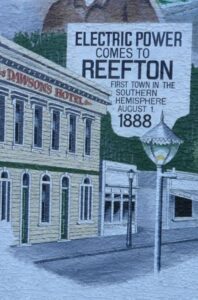 By early December 1888 the electricity scheme was up and running with many new customers plugging in. The Reefton Electric Light Company predicted it would be supplying electric power to 500 lights by Christmas. Rosanowski (2001) relays that “On 16 December the Times said, ‘Reefton is just now pretty well ‘overrun by small itinerant traders and hawkers attracted here by the prosperous Christmas, and who are spreading their nets far and wide for a big holiday haul” “very available shop in Broadway has been occupied and still many applications are unsatisfied. The resident shopkeepers, too, are by no means behind hand in providing for the Christmas trade’. “Enormous quantities of goods of every conceivable kind have been pouring in during the last week or two, and there is great sorting up and replenishing of shelves and windows for 4 display worthy of the occasion’ “Most of the business places in Broadway are now lighted by electricity and, what with crowds of visitors, elegantly decorated windows, and the blaze of electric light, Reefton during the coming holiday evenings will ‘make a considerable show…”
By early December 1888 the electricity scheme was up and running with many new customers plugging in. The Reefton Electric Light Company predicted it would be supplying electric power to 500 lights by Christmas. Rosanowski (2001) relays that “On 16 December the Times said, ‘Reefton is just now pretty well ‘overrun by small itinerant traders and hawkers attracted here by the prosperous Christmas, and who are spreading their nets far and wide for a big holiday haul” “very available shop in Broadway has been occupied and still many applications are unsatisfied. The resident shopkeepers, too, are by no means behind hand in providing for the Christmas trade’. “Enormous quantities of goods of every conceivable kind have been pouring in during the last week or two, and there is great sorting up and replenishing of shelves and windows for 4 display worthy of the occasion’ “Most of the business places in Broadway are now lighted by electricity and, what with crowds of visitors, elegantly decorated windows, and the blaze of electric light, Reefton during the coming holiday evenings will ‘make a considerable show…”
Reefton was at the height of its powers while other towns had been beaten down by Vogel’s Long Depression.
The more accessible gold ran out but Reefton switched to coal. If not for political problems in 1951 I think they would still be pulling gold out of the ground at Big River and Waiuta. Ref. 1951: Cave In at Waiuta, AHNZ
Instead, Reefton has been at a low ebb for the past several generations. Not allowed to mine for gold or coal, they are also prevented from developing their beech forests. Hippy Boomers, especially with their Maruia Declaration (1975) put a brick on Reefton’s ambitions for timber. And, humiliatingly, Helen Clark’s Labour 5.0 Ministry took away the West Coast’s productive industry and exchanged it for a $99 million compensation package called Development West Coast (2001.)
“Reefton…80km from both Westport and Greymouth. At the junction of three main highways..Formerly the largest quartz mining centre in the South Island, Reefton gradually changed to coal…the district has boasted more than 180 coal mines…Reefton has suffered from the decline in the coal industry…its brightest future lies in the proposed beech forest pulp and paper scheme.” – NZ Today pt2 (1973)
“To the outsider Reefton today can look like Rip Van Winkle’s legendary Sleepy Hollow…what the town really needs is cash flow. That could come from the Macraes gold mines and the beech forest timber scheme, both of which are, ironically, like Reefton’s progress, on hold.” – Press (1998)
A modern Warragal visiting Reefton would find it a shadow of its former self. Apart from some charity case rescues, many of the historical buildings were allowed to rot away. Enough heritage houses and buildings, monuments and rusting iron, remain though to indicate that mighty Coasters once dwelt here. I don’t think a tourist visiting today would know what sort of people Reeftonites used to be or understand why such a remote place was once buzzing at the cutting edge of energy technology. It’s only thanks to my happening to read Lord and Rosanowski at about the same time that I clicked on to the real history of what made this antique polis pulse. It was a capitalist oasis when New Zealand was in a period of economic flatlining. It really was worthy of the name quartzopolis.
—
1 Ref. The Observer (1895,) Papers Past
Image ref. Broadway, Reefton, c. 1878. Henry Thomas Lock, Alexander Turnbull Library. AHNZ enhanced (2024)
Image ref. Reefton Courthouse est. 1872. Yet another William Henry Clayton design. Discontinued 1972. AHNZ Archives (2022)
– See 1979: Country Courthouse Culling, AHNZ
Image ref. Reefton mural (2008,) Alexander Turnbull Library
Image ref. Abandoned boiler at Grey River, AHNZ Archives (2024)
Ref. Reefton and its Inhabitants, The Warragal. The Weekly Press (1887,) Papers Past
Ref. Bottled Lightning, John Rosanowski (2001)
Ref. New Zealand’s Heritage (NZH) (1971)
Ref. Old Westland, Iveagh Lord (ee1976)
Note: I have wondered if Reefton might have felt some decline that they were not ready to accept so turned to electricity. That seems to be what happened in that other famous gold town, Thames, when their gold ran out they attempted an ambitious innovation to in the form of a harbour project. Ref. 1925: Burke Street Harbour Project, AHNZ
 Like Comment Share
Like Comment Share
